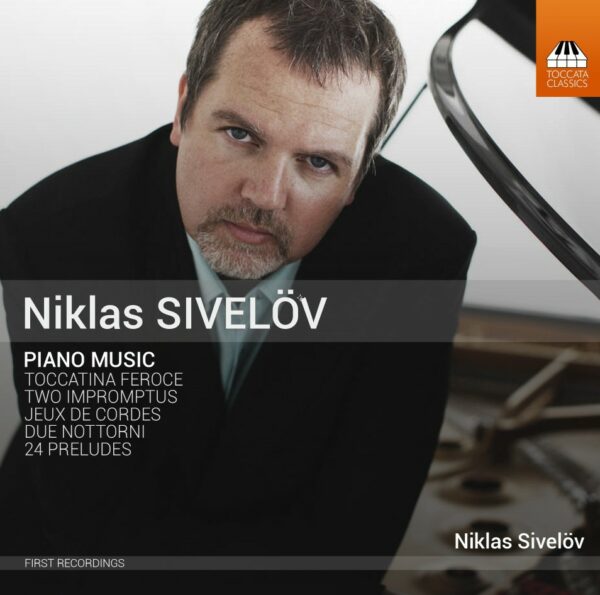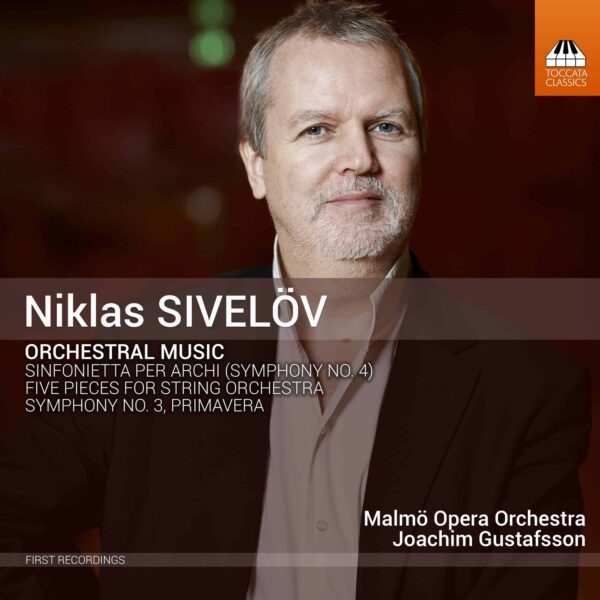Niklas Sivelöv: Piano Music
The tradition of the pianist-composer features some of the best-known names in music, among them Mozart, Beethoven, Chopin, Brahms and Rachmaninov. Now the Swedish pianist Niklas Sivelöv (born in Stockholm in 1968) humbly joins their ranks, with music coloured by a range of influences, from Bach to jazz. This recording presents some of his early compositions and some of his most recent.
Niklas Sivelöv, piano
Listen To This Recording:
- 24 Preludes: No. 1: Allegro con brio
- 24 Preludes: No. 2: Andante fugato
- 24 Preludes: No. 3: Moderato con moto
- 24 Preludes: No. 4: Vivace
- 24 Preludes: No. 5: Adagio con dolore
- 24 Preludes: No. 6: Scherzando
- 24 Preludes: No. 7: Quasi Marcia
- 24 Preludes: No. 8: Andante
- 24 Preludes: No. 9: Allegro di molto
- 24 Preludes: No. 10: Adagio mesto – attacca
- 24 Preludes: No. 11: Andante
- 24 Preludes: No. 12: Allegro misterioso
- 24 Preludes: No. 13: Allegretto dolce
- 24 Preludes: No. 14: Allegro
- 24 Preludes: No. 15: Ben colorato
- 24 Preludes: No. 16: Vivace – attacca
- 24 Preludes: No. 17: Moderato con anima
- 24 Preludes: No. 18: Con spririto
- 24 Preludes: No. 19: Allegro molto, ’Fanfare’
- 24 Preludes: No. 20: Andante maestoso
- 24 Preludes: No. 21: Allegretto
- 24 Preludes: No. 22: Lento triste
- 24 Preludes: No. 23: Allegro molto
- 24 Preludes: No. 24: Allegro con brio
- Due Notturni: No. 1
- Due Notturni: No. 2
- Toccatina Feroce
- Two Impromptus: No. 1
- Two Impromptus: No. 2
- Jeux de Cordes


Fanfare Magazine :
‘His broad performing repertoire, from Bach to living composers, is reflected in his music for solo piano. This is not to say that Sivelöv does not write with original flair and energy, but it is probably most useful to consider this material as homage. The very choice of a set of 24 preludes is a strong nod towards Chopin and Bach, among others, and the ghosts of both of those giants appear in this music. The strongest flavor here is 20th-century Modernism, in the manner of Prokofiev or Hindemith, material that itself is often in a Neoclassical style. As a generalization, Sivelöv sounds like both a performer and composer who works in a joyous and even humorous way. This is heard in fast, loud music and a tendency to run up and down the keyboard. Some of the music is even a bit bangy, but in a fun way. One of the preludes is described in the composer’s notes as having no key signature, and he directs the pianist to use the forearms to create clusters of notes. …
He returns to a kind of Lisztian bravura in the Toccatina Feroce and finds entrancing sonorities in the Jeux de Cordes, which is played standing up so that the pianist can strike the strings of the piano by hand with a mallet. … It is a fittingly interesting and enjoyable way to conclude a delightful recital by this talented young artist.’
—Peter Burwasser, Fanfare Magazine Magazine, March/April 2016
MusicWeb International :
‘The major work here is the series of 24 Preludes, written between 2010 and 2015. Consciously seeking to write a cycle in the tradition of Chopin, Scriabin and Debussy is one thing but aligning, as Sivelöv says, with the influence Bach and jazz is another entirely and presents quite a potentially potent stylistic pottage. … There’s a tangy bite to some of these preludes – a brusque little March theme, a loquacious cantilena, a barbaro that suggests Bartók, virtuosic panache, terse romanticism in miniature, the use of the forearms to play clusters in a misterioso mood, harmonic wanderings, atmospheric quasi-improvisatory passages, and even the introduction of a French Overture [No.20] that has the effect of a similar contextual moment in the Goldberg Variations. As if all this wasn’t enough we find a few Arabic-inspired phrases in the penultimate Prelude and a fittingly dramatic conclusion. The composer is his own best executant but I hope pianists pick up on this cycle or cherry-pick from it. … The first of the Due Notturni shows the dreamier side of the composer’s muse whilst its companion gravitates to active intensification of material shared between the hands. There’s a brief Toccatina Feroce that certainly lives up to its name, and two Impromptus from 2015. The first is deliberately Satie-like though soon moves away from that rather stifling atmosphere. The second is rather quiet and showing once again the quasi-improvisatory qualities that must have been gleaned from jazz. Jeux de Cordes is all dynamism and rhythm. He plays with the mallet on the strings of the piano with one hand whilst the other takes a more conventional route via the keyboard. Exciting.’
—Jonathan Woolf, MusicWeb International
Norran :
‘Recordings like this tend to develop into a tricky and problematic musical adventure. The risk is that the composer might get into a narrow box when interpreting his own work as there is no “second opinion” on the works, no chance to look at them from a different perspective. … But Sivelöv managed it well. He let go of the music, let it live its own life, let it be outside the box but never too much. … he finds himself in a musical borderland. He is inspired by composers such as Johann Sebastian Bach, Robert Schumann and Frédéric Chopin and sprinkles this with big, heaping measure of modernism although there are also clear and distinct jazz influences. Best track, or rather, the funniest one is the most innovative: Closing “Jeux de Cordes,” composed in 2015 and played while standing with a wooden mallet in one hand which used to strike the string.”
—Mikael Bengtsson, Norran
Music and Vision :
‘Sivelöv can be regarded as a boy prodigy, playing the organ when he was six, and winning prizes across the whole of Scandinavia while attracting attention for his dexterity both as an improviser and composer. … This CD, interpreted by the composer himself, is his first for the Toccata label, and comprises a programme of his best piano works… His music belongs most definitely to the modern sound world, but on closer scrutiny, one can detect a certain colouring by a range of influences from Bach to jazz. … the composer’s own description of his works in the sleeve note is certainly invaluable, and is a must read exercise if you want to appreciate this highly mature yet multi-faceted language which needs repeated listeningto get to the bottom line of Sivelöv’s marvelous technique and improvisational skills. … certainly worthy of serious investigation. Sound and presentation are first-rate.’
—Gerald Fenech, Music and Vision, March 2016
Fanfare Magazine :
‘He’s not only a virtuoso pianist, though; he is also a virtuoso composer. … These Preludes are all character pieces, as each one is inspired by someone who has had an impact on the composer’s life… But it is important to note that there is an individual voice here, one that holds secrets and is keen to keep the listener at a certain remove (e.g., the chorale-based but Nordic folk music influenced No. 8). …Sivelöv is clearly his own best advocate. He possesses the full virtuoso apparatus. This is a breathtaking achievement. … Deliberately programmed to provide respite after the Preludes, the first [Notturno] opens with a sort of Debussian haze before moving off on a more bitonal pathway. Impressionism again informs the second of the Notturni, its descending droplets of sounds perhaps simultaneously invoking late solo Brahms piano pieces. Sivelöv’s hushed, delicate performance, particularly of the second piece, is magical. The Toccatina Feroce (2014–15) … is an impetuous work that whirls headlong to its conclusion, ideas passing and hardly graspable, like watching the scenery from inside a high-speed train. … The composer describes the First Impromptu as setting off “a little like Satie”; the present reviewer found the reference immediately audible and unmistakable. … again the composer identifies his own influence for the opening of the second Impromptu (it’s Rachmaninoff, in a darker vein). The music moves on, highly atmospherically, to sounds that seem to combine the Eastern with proto-Minimalism. Finally, Jeux de Cordes … sounds very much like John Cage in Sonatas and Interludes mode. … This was recorded, standing up, in one take—a remarkable achievement, as anyone who hears the recording will attest. In short, this is a fascinating, involving disc by a multi-faceted musician. The recording is terrific throughout, with plenty of presence.’
—Colin Clarke, Fanfare Magazine, May/June 2016
Fanfare Magazine :
‘But what I left with was a subtler enjoyment of the way his mind has assimilated so much iconic Western classical music, which then enters his own compositions like benign ghosts. The First Prelude, for example, begins so close to Schubert’s Marche militaire that it feels like an hommage until Sivelöv’s quick, restless imagination veers off at unexpected angles. This is fascinating music that is made approachable by the composer’s lucid writing. Finally, Sivelöv plays a fine Steinway D that has been captured in flawless recorded sound.’
—Huntley Dent, Fanfare Magazine, May/June 2016
American Record Guide :
‘On the whole I found Sivelov’s 50-minute cycle interesting and diverting, […]
Sivelov’s plays his music with flair and authority, and Toccata’s sonics are clear and clean. […]
Listeners like me who are always curious about new or undiscovered prelude cycles, or better, prelude-and-fugue cycles, should investigate Norwegian composer Frank Nordensten on Hemera 2941. The level of contrapuntal skill and invention in his set is flat-out astonishing; Nordensten comes up with the most recalcitrant fugue subjects imaginable and then confidently builds rhythmically intricate but entirely convincing polyphonic edifices out of them, one after another. Johann Sebastian would approve.’
—Bradley Lehman, American Record Guide, March 2016